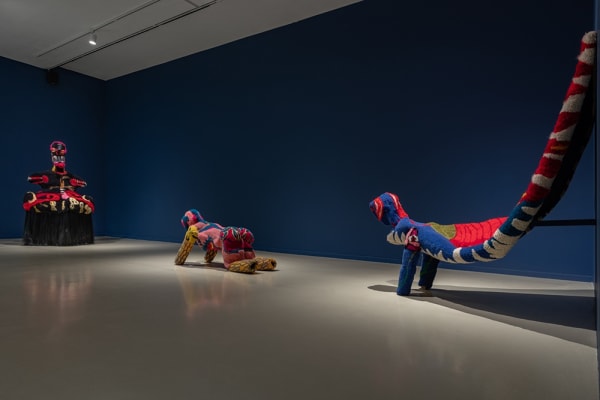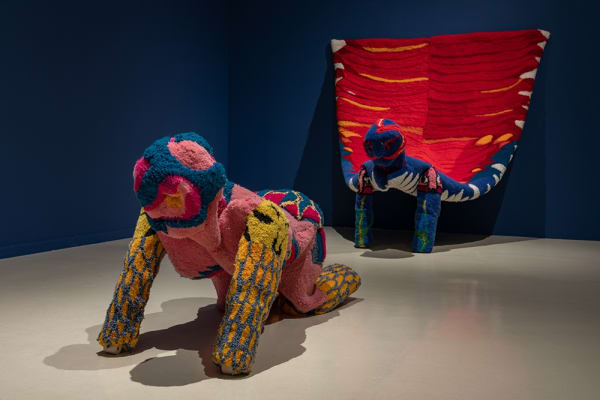- X
- Tumblr
The name of the exhibition – The Moon Prophecy –draws its inspiration from apocalyptic sermons and astrological theories that linked the phenomenon of lunar eclipses to biblical prophecies of the End of Days – as in Joel 3:15, “The sun and moon will grow dark, And the stars will diminish their brightness.” Anna Perach brings to her exhibition a darkly appealing visionary dimension of a closed transformative system, in which the inanimate comes alive, the meek become dominant, and the familiar becomes alien.
At the center of Perach’s exhibition are three sculptures on a human scale. Their placement in space is revealed as a progressive series: the first figure (dubbed Dorothea), bearing a pattern reminiscent of the magical firebird, emerges from the wall – the traditional place of carpets in Slavic cultures – and is supported on the floor with her two arms. The central figure (Rusalka) rises from the floor, crouching on all fours – belying the traditional floor-covering function of rugs. The third figure (Luna) has broken free from both wall and floor as the conventional placements of rugs. It is poised independently in space, suggesting the power and allure of the immortal Baba-Yaga witch figure.
In recent years, Perach has developed a work practice centered on creating wearable sculptures via a carpet-making technique using a tufting gun. During her exhibitions, live performances are held, featuring performers donning and embodying the sculptures with ritualistic choreographed movements blending together modern dance with ancient cultic dances. On completion of the performance, the moving sculptures return to being static and autonomous sculptural objects, held in place by internal custom wooden constructions.
Perach chooses her craft as a culturally charged pursuit, and not just from her personal experience of immigration to Be’er Sheva from Soviet Ukraine. Over the centuries, the status of oriental tapestries in Russian culture has undergone changes – from the glorious days of the Empire in the seventeenth century, when they expressed its long-ranging control as far as central Asia and the Caucasus (acknowledged centers of the finest tapestries), to their industrialized incarnation in the twentieth century as valiant attempts at beautifying and improving the thermal insulation of bleak Soviet housing.
When wearing Perach’s tufted sculptures, they form a link to the diverse folkloristic legacies that have greatly influenced their ornamentations, from decorative traditions to genres of Slavic embroidery. As costumes, they effectively insulate one from the outside world and restrict one’s movement and actions in space. At the same time, they also underscore one’s presence within them and endow it with captivating drama. The mantle that Perach creates thus reflects internal experiences of inter-cultural transitions and culture shocks of immigration, as well as ever-changing self-representation and gender perception.


